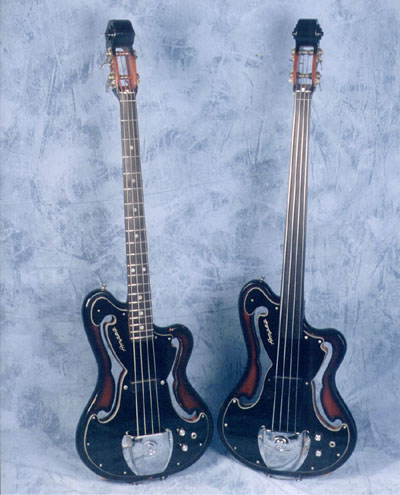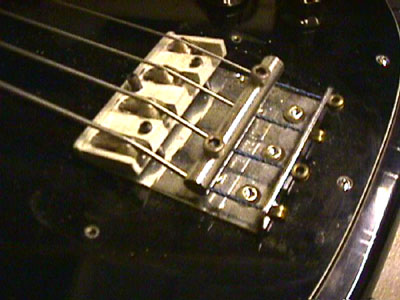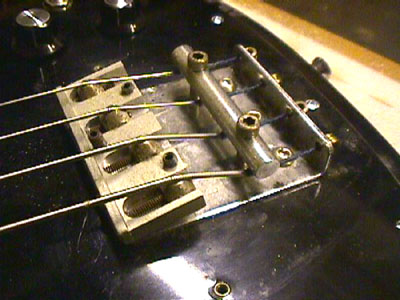
In My Collection:
On the left is AMB-1 #000269, which I bought in 1989. It's all original and in
nice condition. Someone had pulled the frets a few years earlier and put in
white lines, but they did a neat job, and I was able to refret it without
damaging the fingerboard.
On the right is AMUB-1 #000290, which I was very lucky to buy in a private sale
in 1997. It's all original, and has obviously played thousands of gigs. It has a
beautiful sweet tone.
Sorry, these instruments are not for sale!!


This is what the AMB-1/AMUB-1 bridge assembly looks like with the bridge
cover removed. On some instruments, the bridge has to be tilted forward like this to
minimize string buzzing. The serial number is stamped on the face of the bridge plate,
just behind the round bar.
Vintage Ampeg Models:
Vintage Ampeg Main Page
AEB-1 & AUB-1
ASB-1 & AUSB-1 Devil Basses
SSB & SSUB Short Scale Basses
General Information On Vintage Ampegs:
Setup, Maintenance & Technical Issues
Restorations & Parts
|
|
Sometime in late '67, Ampeg began to work on a new model Scroll Bass, to address
the customer complaints and manufacturing problems that they were having with the
AEB-1/AUB-1 models. The "mystery" pickups had been troublesome to manufacture
consistently, and tempermental on the road. Also, rock music was evolving rapidly, and
electric bassists now wanted a full range, thundering sound. The AEB-1 didn't have enough
range, and many Ampeg customers were adding new pickups to their basses as soon as they
got them.
The AMB-1 (fretted) and AMUB-1 (fretless) Scroll Basses appeared in early 1968 to try
to bring the Scroll Bass design closer to the dominant Fender P-Bass culture. These models
were made through mid 1969, although some leftover stock instruments were sold out
through 1970.
At a glance, the AMB-1 looks like the earlier AEB-1, but it's actually a completely
different instrument with significant changes throughout. The headstock was reshaped
to a smoother profile on the back, without the cello-like hook of the AEB-1. The
AMB-1's body is solid maple, without the plywood back. However, I recently restored an AMB-1 with a high serial number, and found that the body was poplar, not maple. It was lighter weight and had a nice sweet tone. They may have been experimenting towards the end of the production run.
Overall, he machining of the body and neck is much more precise and consistent than on the
earlier instruments.
The "mystery" pickup was replaced by a black rectangular magnetic pickup mounted
in the middle of the body. The pickups were made in Ampeg's shop, and are quite
unique for the time. There's a separate coil for each string, and they're wired
together alternately to form a humbucker. The whole assembly is cast into black
epoxy.
The AMB-1's tailpiece is similar to a Fender; a bent steel plate that supports
the bridge and is screwed down onto the top surface of the body. This allows them
to use standard "extra long" strings, giving the owners much more choice and
convenience. The aluminum bridge is similar in design to the AEB-1, but with three
height adjusting screws instead of two. A round steel bar is mounted over top of
the strings, behind the bridge, and it is used to adjust the angle of the strings
over the bridge saddles. A large chrome cover with an embossed "a" logo
on the face fits over the whole bridge area.
Most AMB-1's and AMUB-1's that are around today are in fairly good condition. Overall,
they're higher quality instruments than the earlier models, and most have been well
cared for. The lacquer finish is usually cracked, but it has stayed on well. Almost
all of these two models came from the factory in the standard Ampeg black/red sunburst
scheme with an ebony fingerboard. I know of only one instrument that appears to have
been all black from the factory, although I've seen several that have been repainted
all black.
From the player's standpoint, the AMB-1 and AMUB-1 are the best of the scroll bass
family. They have a wider tonal range than the AEB-1 and AUB-1, but still have the
distinctive warm, bassy Ampeg thump. Unfortunately, they didn't sell very well
initially and production was cancelled in mid '69. A few bassists such as George
Biondo of Steppenwolf and Michael Been of The Call played AMB-1's through the
'70's and '80's. Today, musicians who own AMB-1's and AMUB-1's treasure them, and
a surprising number of them are still played regularly by professionals. They rarely
appear for sale.
The serial numbers of these models are stamped on the tailpiece, just behind and under
the string hold-down bar. It's a six digit number with a bunch of zeros, starting
(I presume) at #000001 and going up to about #000600. The highest number I know of so
far is #000591C. I have information on a lot of AMB-1's and AMUB-1's in my database,
but it's curious that I've only heard of one with a serial number under #000200. It's
possible that the production run didn't start at #000001, and the early numbers may
have been assigned to the prototypes, or may even have been
mixed in with the short-lived SSB/SSUB models.
There are other mysteries in the serial numbers. Some AMB-1 and AMUB-1 models over
#000500 have an "A", "B, "C", or "D" stamped at the end of the serial number. There are
a lot more "C"'s than "A"'s and "D"'s, and I've only seen one "B" so far. I'm not sure
what this means. Some of these instruments have some factory custom features, and
others appear to be standard. Since so few were being built at that time, it may
even indicate which employee built the instrument. Also, there's an AMB-1 marked
#00371; someone forgot one of the zeros.
Taking all that into account, I estimate that 300 AMB-1's and 200 AMUB-1's were built,
and most of them are still around today.
|
|

